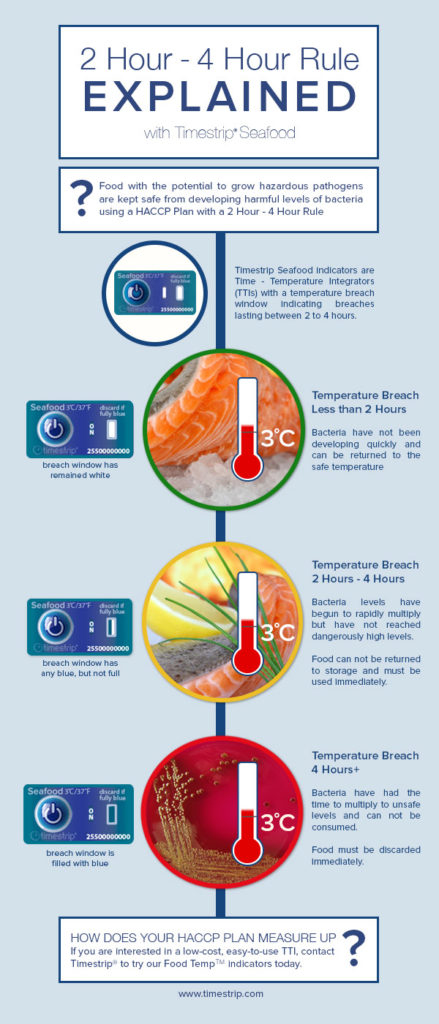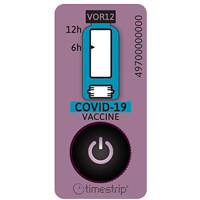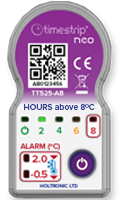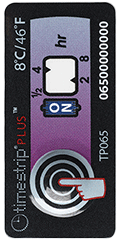Timestrip UK Ltd have expanded their range to include their latest Timestrip PLUS™ 10°C threshold indicator with a 7-day run-out/recording window. This specific indicator is meeting the demand within the pharmaceutical industry and the regulations and compliance that come with transportation and storage. With Timestrip’s latest 10° 7 day offering, they are reaching out further within the Pharmaceutical and Healthcare industry and ensuring their high tech but low cost devices are evolving with the relevant advances in the industries.
7 Day Pharmaceutical temperature breach indicator
Timestrip design and manufacture innovative, irreversible time and temperature indicators for a range of industries from Food to Pharmaceutical. Their Timestrip® PLUS range is predominantly used across the Healthcare, Life sciences and Pharmaceutical arena. Currently, the Timestrip PLUS™ range covers temperature thresholds from -20°C up to 38°C and generally display a run-out window of any temperature breach for 8, 12 or 48 hours.
Combining time & temperature monitoring patented technology, which involves controlled rate lateral diffusion of liquids through the device membrane once activated. If a breach occurs, the ‘smart’ indicators will visually indicate how long a product has been exposed to higher temperatures.
For a free sample of the new 10° 7 day indicator, or to place an order click here
Content by MW Communication
Already in 2012 the world’s third largest importer of seafood, the UN's Food and Agriculture Organization predicts that China in 2016 is set to become the world’s top destination for seafood imports. Key economic data and trends point to further growth in domestic consumption and, despite indications that the country’s economy is slowing, it has nevertheless trebled in size since 2001, with Forbes magazine predicting it will surpass the US in scale in 2018.
This growth in China’s seafood imports comes at a time when the seafood sector generally is in excellent shape, growing at a faster rate than any other protein industry with the world’s top 150 seafood companies generating $107bn in sales in 2015.
Unsurprisingly, China’s top suppliers are almost all situated around the Pacific basin. In 2013, Russia was in first place with a 17.8% share followed by the US (15.3%), Peru (12.1%), Chile (5.3%), Norway (5.1%) and Canada (4.8%), with other seafood imports being sourced from over 100 other countries. That year in value terms, its main seafood imports included flours and meals of fish, used in animal feeding ($1.7 billion); frozen Alaskan pollock ($883.6 million); frozen cuttlefish and squid ($445.9 million); and frozen cod ($434.0 million).
This astonishing growth in seafood imports is explained by a variety of factors:
Firstly, higher Chinese incomes have fuelled an increase in domestic demand: between 2001 and 2014, real wages in China rose fourfold and this trend is ongoing. Data from the Economist Intelligence Unit point to national average urban incomes rising by around 70% between 2012 and 2017, from US$6,291 to $10,791.
Moreover, this increase in domestic demand includes that for high-end seafood imports, such as lobsters come from France, Canada and the US; abalones from South Africa, Australia, and New Zealand; red shrimps from Ecuador and Argentina; king crabs from Russia and Chile; salmon from Chile, Ireland, Scotland, and Norway; and oysters from America, France, and New Zealand. Such products are obviously favoured by wealthier Chinese consumers, but the country’s emerging middle class is also demonstrating a growing appetite for these seafood imports.
An indication of this trend is the recent news report that the Russian Caviar House has begun exporting black caviar to China, with regular annual shipments of 100-150 kilograms currently being planned, according to company director Saodat Sultanova.
The second key factor explaining the growth in China’s seafood imports is that its domestic production capacity has been extremely adversely affected by pollution and thus cannot meet this increase in demand. Indeed, despite it being the world’s biggest seafood exporter, double in value terms of its nearest rival, Norway, the environmental impact of its breakneck economic growth in the last 20 years has created an insurmountable environmental obstacle.
In March this year, China’s Agriculture Minister Han Changfu said: “… the increase in China’s seafood output has come at the expense of the country’s natural environment.” Han also said that the production capacity of the country’s environment has been stretched to breaking point, with various measures undertaken this year to address the situation. These have included the launch of an effort to protect and repair its freshwater fishery resources, an increase in its annual fishing ban on the Yangtze River from three months to four and an extension to the ban to local rivers and lakes. Such actions will inevitably impact negatively on aquaculture hubs like Jiangsu and Hubei, since the Yangtze flows through those areas and means that China is having to source its seafood elsewhere.
Such environmental issues also affect the safety of China’s domestic seafood production, leading to consumers avoiding potentially harmful products.
In 2012, the Ministry of Agriculture (MOA) published administrative measures on the control of agricultural product (including aquatic) quality and safety, which included regulations on risk monitoring and sampling. Also since 2012, a further regulation is that food and beverage exporters to China are required to register through the General Administration of Quality Supervision, Inspection and Quarantine (AQSIQ)
Despite these measures, in November 2016 it was reported that Chinese seafood retailers are increasingly nervous about stocking domestic seafood, which may have excessive traces of antibiotics. Sales outlets are also beginning to eschew selling live seafood, a choice favoured in particular by older Chinese shoppers, who traditionally bought these products from supermarkets and wet markets. Retailers say they are concerned about costly closures caused by failed safety inspections by food hygiene officials. Meanwhile central government affirmed that the safety scare wasn’t due contaminated water in live fish tanks.
This explains another key trend: the growing importance of place of origin for Chinese consumers. The market for seafood from Canada and Alaska for instance have continued to develop, with northern prawns and Canadian lobsters especially popular. Indeed, advertising the places of origin is set to become an ever more important aspect of marketing seafood imports in China, especially where the source is trusted for its rigorous temperature controls and requirements.
Demand for such products is further stimulated with Chinese consumers’ own ongoing positive experience around product quality, texture, safety, etc, all of which is inextricably linked to effective temperature control monitoring throughout the cold chain process.
The regulatory framework for importers is complex. Beyond having to satisfying country origin export regulations around documentation (commercial invoice, packing list, export health certificate, certificate of origin, etc), all products on cross- border platforms such as Kuajingtong, should meet all the requirements set by Chinese regulations, including Chinese language labelling, certification and registration standards.
Also that year, China updated its Food Safety Law, affecting ingredients, testing methods, manufacturing, contact substances, packaging, and nutrition labelling. Two important regulations, including a “Food Traceability System” and “System of Real Name” have been established and allow consumers to require a “continuous compensation”.
Lastly, Chinese regulations can change quickly and therefore it is important for importers to remain up to date with all policy changes. For example, since 2014, China has banned the imports of whole salmon, but not processed salmon.
That said, this know how around regulations is clearly not an obstacle to the many companies already exporting seafood products to China and a major trend moving forward is predicted to be around the development of e-commerce for the sale of imported seafood products.
Fan Xubing is the founder and president of Sea Bridge Marketing in Beijing and has worked for many years as a partner in promoting sales of imported seafood in China, especially online. He says that 2015 saw a rapid development of e-commerce business of imported food generally. Sales of such products including seafood have increased by over 50% and Chinese consumers are becoming accustomed to buying seafood products online.
He also says that 2016 has seen many improvements in cold chain logistics, tighter controls over temperature and more effective regulation related to seafood safety. He points to e-commerce firms such as Jingdong and Womai, which increased their investment in their cold chain logistics, and how it has become increasingly common for Chinese consumers to get the products on the day they order online or the following day.
China’s seafood import sector has been given a significant further – and often underreported – boost with the decision by central government in recent years to allow more regional cities to handle imports of perishable goods, simplifying a significant aspect of import logistics.
In the capital of comparatively wealthy Jiangsu province for instance, this has led to imports of seafood trebling and in Suzhou, which started handling seafood imports in 2015, the AQSIQ predicts more than 1,000 tons of fresh salmon will be imported into the city in 2017. The AQSIQ also reports that this year Nanjing’s Lukou Airport handled 300 tons of salmon from Chile, the Faroe Islands, the UK and Australia.
This surging demand for seafood imports has had, and will carry on having, a profound impact on cold chain logistics. According to market research by ReportLinker, in an environment where most cold chain logistics enterprises often operate both a cold storage and transportation business, the circulation in China of cold chain agricultural (including aquatic) products reached 330 million tonnes, up 16% year on year, and this is projected to double by 2020.
Interview with Reuben Isbitsky, founder of Timestrip UK Limited, which has just received FDA clearance for its 10°C Non-reversible Blood Transit Temperature Indicator.
Beyond its primary use as a temperature monitoring device, what from the user’s point of view are the key advantages for users of Timestrip 10°C nonreversible temperature indicators for blood products over other temperature monitoring products?
First and foremost, ease of use. Unlike other temperature monitoring devices, Timestrip 10°C irreversible blood temperature indicator can be stored at ambient temperature. It doesn’t need to be stored in a refrigerator and also doesn’t need to be refrigerated for at least 24 hours prior to use.
Moreover, until the button on the Timestrip 10°C is pressed, the device remains totally inactive. There is no risk of accidental activation because of the heat generated by warm fingers. All parts of Timestrip 10°C can be handled by warm hands without this leading to accidental activation. This naturally translates into significant cost savings over extremely sensitive temperature monitoring devices that need to be discarded when accidentally activated.
Ease to use temperature indicators
With Timestrip 10°C, there’s no complicated four-minute instructional video with many caveats. All you need to do is take the blood bag out of the cooler, put it down, take the Timestrip, peel off its protective under-layer, press the activation button and stick it on the blood bag. That’s it.
We’ve also built into Timestrip 10°C a fail-safe activation indicator that tells the user that the Timestrip is ready to use and working. This is unique in the market. No other indicator has this feature.
Lastly, we put huge emphasis on ease of readability. With Timestrip 10°C, if there’s a temperature breach, the indicator will turn from white to blue. Thus, if the indicator on the Timestrip has any hints of blue in it, the user knows for a fact that there’s been a temperature breach.
We don’t want there to be any confusion caused by problems of refracted colours from misleadingly coloured components of temperature monitoring devices indicating that a temperature breach has occurred, when in fact none has. This only leads to uncertainty, which at best means more costs to users because of unnecessarily discarded, but otherwise properly functioning monitoring equipment, and at worst viable blood is unnecessarily discarded.
Blood is an extremely precious commodity and no one wants to be using an unreliable temperature monitoring device that leads to throwing away good blood. As one of our users in Europe says: “Blood is life.”

Visit the Timestrip Food Indicator page for solutions
Interview with Reuben Isbitsky, founder of Timestrip UK Limited, which has just received FDA clearance for its 10°C Nonreversible Blood Transit Temperature Indicator.
What does FDA clearance of Timestrip 10°C mean for your company?
It’s major milestone. Product-wise, we've been deemed and certified as having a medical device that has an accuracy level of ± 0.5°C and is suitable for transporting whole blood. FDA clearance for Timestrip 10°C will allow us to market this product for this specific application.
And for our business, it marks a very important turning point. We started off as a time indicator company, which evolved into a temperature monitoring business, that is now a high-end medical device and healthcare business.
Moving forward, our business model will be to configure new products for specific and invariably speciality uses. We’re also going to be expanding our range of products for specific uses to enable the safe transportation of the different components of whole blood as well, namely platelets, plasma and frozen blood products. This will go a long way to maximizing the usability of all these components. For instance, even properly transported and stored whole blood only has a shelf life of 35 days, but plasma can be frozen and has many uses.
Lastly, for markets outside the US FDA clearance gives our product enormous credibility. Although FDA clearance cannot be enforced outside the US, in fact for many markets such as Saudi Arabia and India, it is used as an indicator of credibility and for tendering processes is even a prerequisite.
Timestrip® has a new range of Food Temp™ indicators which have been specifically developed for food shipping and storage.
The newly designed temperature breach window on the Food Temp™ 5°C indicates breaches lasting between two to four hours.
Why 2 Hour – 4 Hours?

In the food industry, food with the potential to grow hazardous pathogens are kept safe from developing harmful levels of bacteria using a HACCP Plan with a 2 Hour - 4 Hour Rule.
If the food is exposed to a temperature breach for less than 2 hours, bacteria have not been developing quickly and can be returned to the safe temperature.
Users can see that the breach window on the Food Temp™ indicator has remained white and can return products to the safe temperature.
If exposed to breach temperatures above 2 Hours, but under 4 Hours- bacteria levels have begun to rapidly multiply but have not reached dangerously high levels.
When users see blue in the breach window, it will alert them they must use the food immediately and cannot be returned to storage.
After a 4 hour exposure to a temperature breach, bacteria have had the time to multiply to unsafe levels and cannot be consumed.
A completely blue window on a Food Temp™ indicator lets a user know that the food product is unsafe to use and must be immediately discarded.
For more information, see our Food Temp Indicator page.
Timestrip is pleased to announce the arrival of our 6ºC blood bag temperature indicator- Blood Temp 6.
Blood Temp single use temperature indicators
Blood Temp 6 single use temperature indicators are low cost, field activated, and irreversible – they have been designed to be adhered directly to blood bags and are calibrated specifically to monitor the 6ºC threshold.
Use for monitoring temperature exposure when blood bags are in transit from storage, as in hospital blood banks. Blood Temp 6 provides a simple visual indication that blood has been stored and transported below 6 degrees Celsius.
Along with our existing 10ºC product, Blood Temp 10, and our 25ºC Extreme room temperature indicator, Timestrip Plus 25ºC, Timestrip indicators are ideal for all your blood bag monitoring needs.
DHL Global Forwarding opened it's purpose built temperature controlled warehouse to process pharmaceutical, biotech and medical devices in Chicago's O'Hare airport.
With 10,000 temperature controlled square feet situated in the world's busiest airport, businesses now have better ways to get their temperature controlled healthcare products all over the globe.
Whether your products are being flown internationally, or shipped overground locally, you need to be sure temperature breaches have not occurred in transit.
Temperature monitoring in pharmaceutical warehouses
Timestrip® has a line of temperature breach indicators that are small, easy-to-use, cost effective indicators that and provide auditable proof that your devices arrived safe to use.
Our Timestrip® Blood Temp 10 indicator is a single use ascending temperature breach indicator that can be applied directly to a blood bag, and will visually alert you to a 10°C breach of the blood bag's core temperature.
For all other temperature monitoring needs, our Timestrip® PLUS line monitors ascending temperature breaches in a variety of temperatures between -20°C and 30°C.
Timestrip is proud to announce the successful certification to ISO 13485:2003 Quality Management Standard for Medical Devices in addition to our recent recertification of ISO 9001:2008.
Recognised around the world, the ISO 13485:2003 registration is based on eight quality management principles. These include: customer focus, leadership, involvement of people, process approach, system approach to management, continual improvement, fact-based decision-making and mutually beneficial supplier relationships.
The certification of the Company’s compliance with ISO 13485:2003 recognizes the policies, practices and procedures of our firm to ensure consistent quality in the products provided to our customers. With this certification, our medical and non-medical clients can be confident that Timestrip is dedicated to maintaining the highest efficiency and responsiveness achieving our ultimate goal – Guaranteed Customer Satisfaction.
Timestrip is certified as meeting the requirements of ISO:13485 for the following activities: DEVELOPMENT AND MANUFACTURING OF SMART LABELS FOR MEDICAL USE.
To maintain our certification, Timestrip will perform annual audits to ensure compliance and to assess initiatives for continued improvement. Our customers can be confident that Timestrip will continue to provide the high quality services they have come to expect well into the future.
We believe that our decision to become ISO 13485 Certified is a proactive one that not only anticipates the demands of our customers, but also demonstrates our commitment to providing quality services to all our customers in the medical industry. We strongly believe augmenting our certification offers our customers a “Best-in-Class” choice for smart labels.
The accreditation also supports our work in pharmaceutical categories, where a range of Timestrip products are used to identify temperature breaches in highly regulated cold chain environments. We are helping to protect patients and prevent unnecessary wastage of many drugs, vaccines and blood products, where the 2-8°C/46°F storage range is critical to so many products.
Timestrip indicators are leading the market in the provision of low-cost temperature indicators, as demonstrated by our blood bag temperature monitoring labels. In 2013 we launched the Timestrip Blood Temp 10 indicator, in response to the need to reduce wastage of precious blood stocks, discarded through uncertainty around temperature breaches incurred when bags are in use and removed from carefully controlled refrigeration storage units in blood banks.
In 2014, Timestrip UK Ltd announced it is working with Belgian Red Cross-Flanders to develop new blood temperature monitoring labels with a product development program looking to create optimal temperature monitoring labels for the blood collection, distribution and transfusion organisations operating within the Flanders catchment area.
Temperature monitoring labels based on the existing Timestrip Blood Temp 10 product are now being developed and reviewed in consultation with Belgian Red Cross-Flanders.
Also in 2014 we were proud to be the technology of choice for an innovative new product created to provide a wearable, low-cost vaccination reminder product for new-born children.
The Bill Gates Foundation funded Vaccine Reminder Band is currently undergoing field trials in Pakistan. Timestrip has a long history of innovation in the medical device sector and we now provide a range of products which act as invaluable visual aids to doctors, patients and healthcare workers.
For example in the UK, a number of NHS dispensing pharmacies are already using Timestrip® PLUS to monitor the cold chain for temperature-sensitive drugs such as Neulasta® and Total Paternal Nutrition (‘TPN’) products.
Timestrip is committed to quality assurance processes and procedures and we see the ISO 13485:2003 Quality Management Standard for Medical Devices accreditation as a natural progression of our work in the specialist markets in which we aim to excel.
Belgian Red Cross Flanders enters joint development agreement with Timestrip.
London/UK – September 17th 2014, Timestrip UK Ltd has announced it is working with Belgian Red Cross-Flanders to develop a new blood temperature monitoring label.
Timestrip today confirmed that such product development will look to create optimal temperature monitoring labels for the blood collection, distribution and transfusion organisations operating within the Flanders catchment area.
Temperature monitoring labels based on the existing Timestrip Blood Temp 10 product will be developed and reviewed in consultation with Belgian Red Cross-Flanders.
Belgian Red Cross-Flanders conducted lengthy investigations into different current temperature monitoring solutions for blood bags taken from sophisticated refrigeration units, leaving the blood banks for transfusion in theatre or if required at a secondary location.
Blood bag temperature monitoring with Belgian Red Cross
Clear and accurate monitoring of the core temperature of individual blood bags is required to identify ascending temperature breaches and prevent blood stocks being returned into the cold chain if unused after specified times or adversely affected by temperature.
The aim of this joint development initiative is to help define and pilot a range of smart labels that monitor critical temperature excursions.
The program agreement was signed by Philippe Vandekerckhove, Director General of Belgian Red Cross-Flanders, Reuben Isbitsky of Timestrip UK Ltd and Chris Van Sebroeck of Innolabel, Timestrip’s distribution partner in Belgium.
Commenting on the project, Timestrip Founder Reuben Isbitsky said “This is a milestone moment for Timestrip and we are delighted that Belgian Red Cross-Flanders has chosen to use our technology to help create optimized labels for these critical monitoring requirements. We believe that new products created as a result of this cooperation will possibly change standard operating procedures on a global scale.. ”



